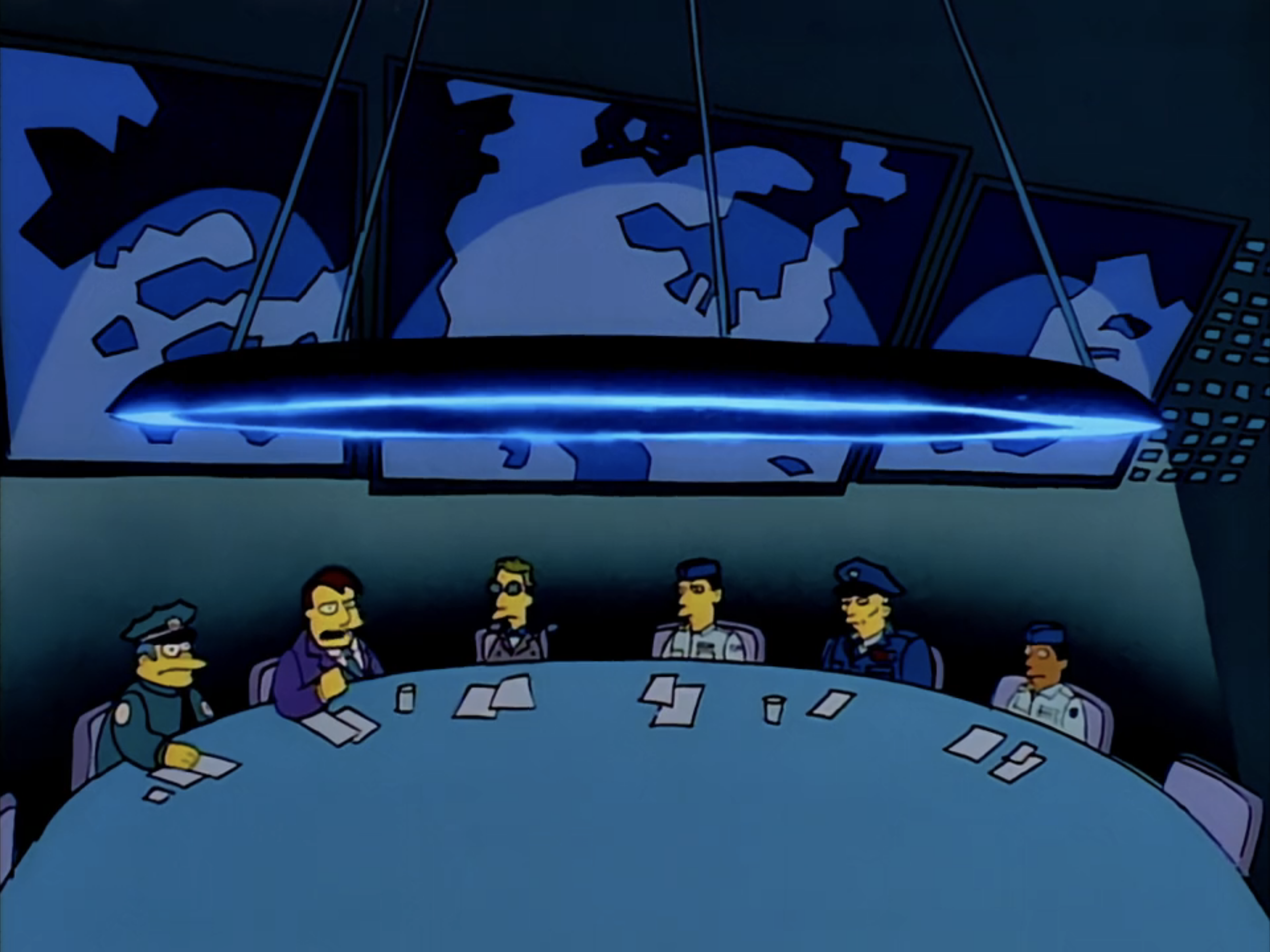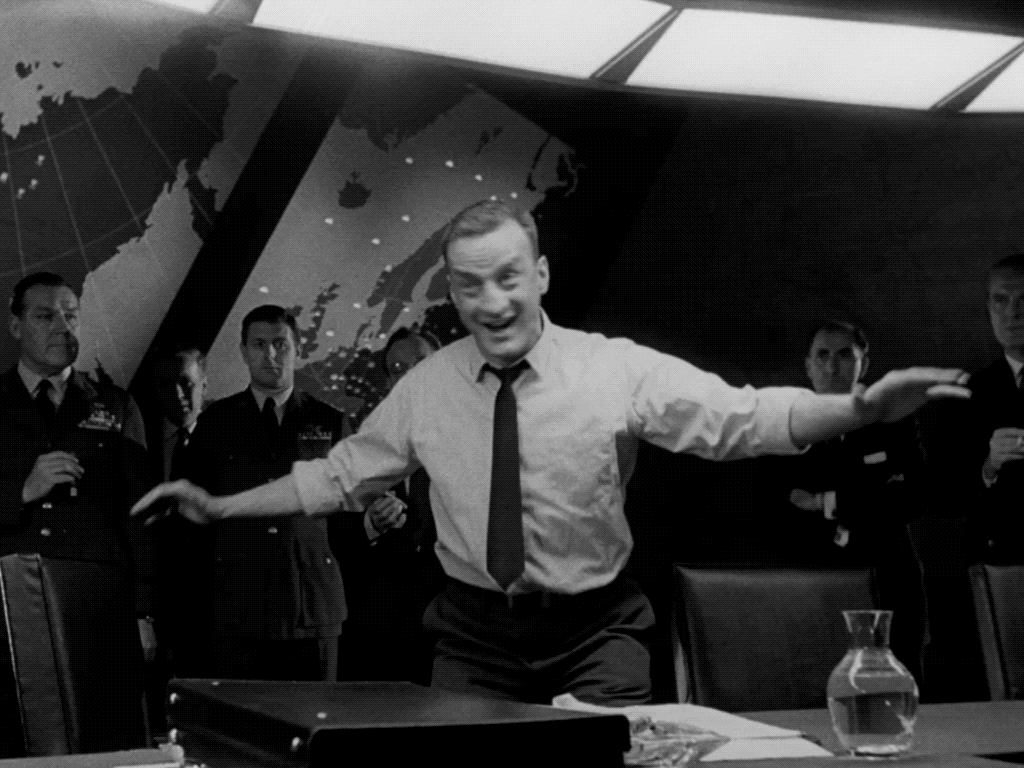Ep. 3 Extras - Dr. Strangepants
or: How I Learned to Stop Worrying and Love Sexual Innuendo
Looking for roundups of more Simpsons movie references? After the first season of the Springfield Googolplex podcast, we started including this kind of extra goodness into the show notes for each episode. Check out our full back catalogue for more!
In episode 3 of Springfield Googolplex (available on Apple Podcasts and Spotify), Nate and Adam revisit Dr. Strangelove or: How I Learned to Stop Worrying and Love the Bomb (1964), our first of many Stanley Kubrick movies we will likely cover on the show, and a favorite of many Simpsons writers.
Read on to see every reference to Dr. Strangelove on The Simpsons, plus some movies to check out if you liked this one, and links to further reading and viewing.
Every Simpsons Reference to ‘Dr. Strangelove’ (1964)
By our count, Dr. Strangelove has been referenced in six episodes of the first 13 seasons of The Simpsons, with particular love and attention in “Sideshow Bob's Last Gleaming” (S7E9).
Like Father, Like Clown (S3E6): A movie titled "Doctor Strangepants" can be seen on an adult theater marquee that Krusty the Clown walks by.
$pringfield (or, How I Learned to Stop Worrying and Love Legalized Gambling) (S5E10): The title of the episode references the movie, of course. But also, two songs by Laurie Johnson, composer of the score for Dr. Strangelove, can be heard during the “News on Parade” segment at the beginning. There’s also another Kubrick reference at play: When Mr. Burns goes full Howard Hughes, his bedroom looks similar to the one occupied by Keir Dullea's character Dave Bowman in the end of the 1968 film 2001: A Space Odyssey.
Homer the Vigilante (S5E11), Wild Barts Can't Be Broken (S10E11) & Mom and Pop Art (S10E19): In “Homer the Vigilante,” Homer fantasizes about dropping an atomic bomb onto beatniks and riding the bomb to destruction, like a cowboy on a rodeo bull just like Major Kong. In season 10, the bomb drop scene is parodied again as the couch gag for two episodes.
Sideshow Bob's Last Gleaming (S7E9): Much like “Dead Putting Society” (S2E6) parodies sports movies, this episode generally parodies 1960s-era nuclear war movies, with several references to Dr. Strangelove. In particular, the underground compound resembles the War Room from the film and Professor Frink was redesigned to parody the title character.
Sideshow Bob's Last Gleaming (S7E9): The tune that Sideshow Bob whistles while preparing his own atomic bomb is "We'll Meet Again", as sung by Vera Lynn at the end of the film. Later, the score includes a cue from “When Johnny Comes Marching Home,” an American Civil War song that also features prominently in the movie.
Sideshow Bob's Last Gleaming (S7E9): Krusty's acting whilst he defends television is based on George C. Scott's performance as General Buck Turgidson. The character of Colonel Leslie "Hap" Hapablap in “Sideshow Bob’s Last Gleaming” also seems to be a loose reference to this type of character and the silly names from Dr. Strangelove. However, the role was specifically written for R. Lee Ermey, who played the iconic drill sergeant in another Kubrick film, Full Metal Jacket (1987). The line "What is your major malfunction?" is taken straight from that film.
Did we miss something? Let us know!
Extra Credit
Enjoyed this movie? Here are a few others we would recommend:
Fail Safe (1964): Did you watch Dr. Strangelove and feel like it wasn’t bleak enough? Then Sidney Lumet’s serious take on the same subject matter is for you. That scary part of “Sideshow Bob’s Last Gleaming” with the crash zooms into everyone’s faces right before the bomb goes off is right out of this film.
Full Metal Jacket (1987): If you’re trying to figure out where to start with Stanley Kubrick’s filmography and you can’t see 2001: A Space Odyssey in theaters, Nate suggests this war movie as a relatable entry point. While it has the same weirdness as his films of the same era, in Nate’s memory it’s not quite as alienating as the ultraviolence of A Clockwork Orange or the glacially slow pace of 2001 and The Shining.
Lolita (1962): Neither Nate nor Adam have seen this one, but we’d be remiss if we didn’t mention that it’s listed alongside Dr. Strangelove on Matt Groening list of 100 favorite things. What’s more, it’s another of Kubrick’s only dark comedies, and another collaboration with Peter Sellers in multiple roles. Despite the stomach churning subject matter, maybe we will have to add this one to our watch list, too.
Plus, here’s some further reading and viewing we came across in our research:
Article: Samuel Wigley, “Rare images of the Dr. Strangelove custard pie fight,“ BFI, January 29, 2014. This photo essay gives a peak into the long lost ending of Dr. Strangelove.
Video: Trailer for Dr. Strangelove, Turner Classic Movies, 1964. Sweet Enola Gay, that’s a great trailer!
Ephemera: “Stanley Kubrick : Dr Strangelove original 1964 US oversized campaign book,“ POPT, 1964. This promotional booklet offered up our summary of the movie for the podcast.
Video: Bob Newhart, “Abe Lincoln vs Madison Avenue,” 1960. Adam pointed out how similar Peter Sellers’ phone calls in this film are to this Bob Newhart bit, and now Nate can’t unsee it.
Article: Mick Broderick, “Animating Kubrick – Auteur Influences in The Simpsons,” Screening the Past, 2017. This offers a nice overview of the many references to Stanley Kubrick on The Simpsons, including Dr. Strangelove.
Article: Allison Hanna, “Matt Groening’s 100 Favorite Things,” 1999. This is the eclectic list we reference of Matt Groening’s favorite stuff, from music to food to movies. In an interview with ‘Round Springfield, Matt talks about writing this originally when he was at the Los Angeles Reader.
Video: “Inside of Dr. Strangelove or: How I Learned to Stop Worrying and Love the Bomb,” Daily Motion, 2014. This 46-minute documentary offers a deep dive into the movie, from conception to execution.












